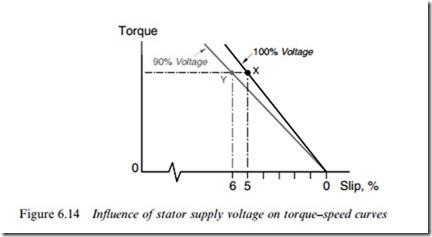INFLUENCE OF SUPPLY VOLTAGE ON TORQUE–SPEED CURVE
We established earlier that at any given slip, the air-gap Xux density is proportional to the applied voltage, and the induced current in the rotor is proportional to the Xux density. The torque, which depends on the product of the Xux and the rotor current, therefore depends on the square of the applied voltage. This means that a comparatively modest fall in the voltage will result in a much larger reduction in torque capability, with adverse eVects which may not be apparent to the un- wary until too late.
To illustrate the problem, consider the torque–speed curves for a cage motor shown in Figure 6.14. The curves (which have been expanded to focus attention on the low-slip region) are drawn for full voltage (100%), and for a modestly reduced voltage of 90%. With full voltage and full- load torque the motor will run at point X, with a slip of say 5%. Since this is the normal full-load condition, the rotor and stator currents will be at their rated values.
Now suppose that the voltage falls to 90%. The load torque is assumed to be constant so the new operating point will be at Y. Since the air-gap Xux density is now only 0.9 of its rated value, the rotor current will have to be about 1.1 times rated value to develop the same torque, so the rotor e.m.f. is required to increase by 10%. But the Xux density has fallen by 10%, so an increase in slip of 20% is called for. The new slip is therefore 6%.
The drop in speed from 95% of synchronous to 94% may well not be noticed, and the motor will apparently continue to operate quite hap- pily. But the rotor current is now 10% above its rated value, so the rotor heating will be 21% more than is allowable for continuous running.
The stator current will also be above rated value, so if the motor is allowed to run continuously, it will overheat. This is one reason why all large motors are Wtted with protection, which is triggered by over- temperature. Many small and medium motors do not have such protection, so it is important to guard against the possibility of undervoltage operation.
